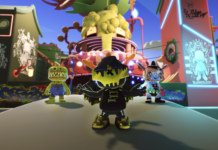Not since the word “deathmatch” was coined has there been a game mode as easily summed up as “F**king Run,” the new multiplayer mode for the upcoming multi-platform title F.E.A.R. 3. We were recently given the chance to try out this interesting take on cooperative multiplayer, and the mode definitely lives up to its title.
“F**king Run” takes many cues from Valve Software’s Left 4 Dead series, a smart move for any developer looking to construct an entertaining four-player experience. Here, however, developers Day 1 Studios have not simply cloned the successful game type. Instead, they’ve taken the core concepts and pushed them to logical extremes. Each stage begins in a safe room, giving the team time to switch out some or all of their arsenal for the many options lying about and discuss some brief strategy for the round ahead. Unlike in Left 4 Dead, where players are encouraged to keep moving but able to set their own pace, your only real option here is to run like f**king hell.
The Wall of Death, a giant, swirling black cloud of impenetrable horror, is sweeping through the city behind you. As you move through the level, the cloud continually follows, gaining ground with every stumble and waiting for the major error in teamwork that will let it catch up with your band of heavily armed brothers. As you progress you’ll reach other safe rooms, a kind of checkpoint system that allows you to catch your breath, refill your ammo, and prepare for the next mad-cap dash. Don’t even think of acting upon your lone warrior instincts, stampeding through the level and leaving your team for dead. If even a single player is caught in the death cloud, the entire team immediately fails. Teamwork is not only essential, but also the most important aspect of the mode.
As you run like scared children from the horrible veil of impending doom, a variety of obstacles will impede your path. Most obvious are the waves of Armacham Technology operatives, suicidal cannon-fodder that apparently embrace the comforting lull of this approaching death and seek to take down anyone who means to escape it. We took note of a few different enemy types, but for the most part, none were particularly inventive and were eliminated without much trouble. The game offers the standard suite of weapons for taking out these opposing forces, including a handgun, submachine gun, fragmentation grenades, and our personal favorite, the assault rifle–a devastatingly powerful gun made even deadlier by its impressive scope range. Also of interest is the slide tackle, which can be used by any player who is dashing (note: all of them) and can instantly K.O. anyone it hits. Obviously, the range is lacking on such a maneuver, though in some of the close-quarter segments it proved an invaluable asset to our arsenal.

The other main obstacle is the levels themselves, designed to trip up players with strategically placed bric-a-brac and sections that force you to move at a reduced clip. Anxiety sets in as you’re forced to climb a ladder or descend a fire escape, knowing the Wall can’t be far behind. The mode ended for us and our three teammates when these two aspects collided: We were unable to effectively suppress the enemy force as we tried to get off the catwalk that we were descending. Once one of us was downed, the others followed suit, and we watched in horror as the Wall consumed us, swept away by a results screen that let us know how poorly we’d fared.
A necessity for this game mode would be a decent headset microphone, allowing downed players to call for assistance or to bark out orders to players trying to navigate some of the trickier sections. Of course, 99% of the chatter will likely consist of your teammates screaming some variation of the mode’s name, though it’s still advisable to keep the voice channel live in case of a more complex strategy.

Overall, the mode was good fun, though we wanted more in terms of multiplayer co-operation. The standard run-and-gun antics were quite competent, but aside from the ability to help downed players back on their feet, the sense of comradery felt a bit lacking. We would have loved to see some sections where players were forced to split up to advance, or perhaps some sort of action-button command that boosts a teammate over a wall or pulls them more quickly up a ladder. Our team wasn’t able to make it to the end, so perhaps we missed out on some surprises. Still, it’s good to see the realm of multiplayer expanding, and this mode could definitely prove to be one of the bigger selling points of the game. Keep your eye on this one for sure.










